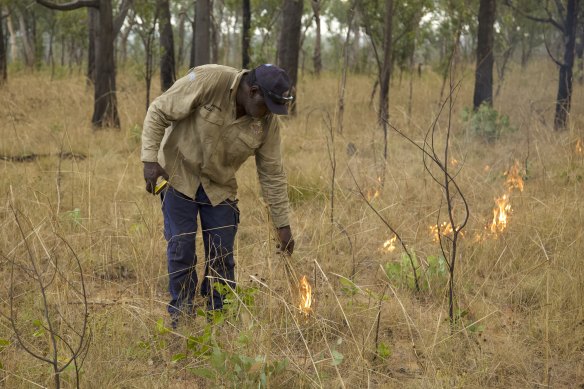Wildfires destroying vast areas of the Kimberley have been drastically reduced by Indigenous fire management in one of the most fire-prone regions in the world.
A detailed study of satellite imagery has found hot, late-season fires have declined across nearly three-quarters of the land surface of the savannah-rich north Kimberley since Indigenous burning regimes were adopted a decade ago. Total fire incidence has declined across 40 per cent of the project area.

Ranger Jeremy Kowan on a fire walk. Credit: Mark Jones
The two-year study, published in CSIRO’s International Journal of Wildland Fire, covers one of the largest areas ever examined for burning impact in Australia, about 640,000 square kilometres – three times the size of Victoria.
It found massive wildfires – more than 40,000 hectares in size and likely to burn for months – occurred during 10 of the 11 years before Indigenous burning methods were adopted.
Only one massive fire occurred in the 11-year period after the change in fire regime.
Concern over intense wildfires and loss of biodiversity in the high-rainfall north Kimberley led four Aboriginal owner groups to create Healthy Country Plans based around a return to traditional burning practices.
The Balanggarra, Dambimangari, Wilinggin and Wunambal Gaambera traditional owner groups jointly operated a carbon emission abatement scheme involving widespread patch burning in cooler months. They said wildfires were now less severe, smaller and less frequent.
A WWF-Australia grant enabled the Indigenous groups to fund expert analysis of the satellite imagery, a painstaking process of comparing the on-ground impact of thousands of fire incidents over two decades.
Dr Rohan Fisher, study co-author from Charles Darwin University, said the use of customary burning regimes had been a twofold success, reducing massive fires and abating carbon emissions.
“On a per capita basis, traditional owners in North Kimberley are doing more of the heavy lifting on greenhouse gas abatement than any other group,” he said.
“We’ve been able to quantify the change and satellite evidence doesn’t lie.
“The scale of achievement across northern Australia makes other fire mitigation programs pale into insignificance.”
Fisher said savannah grassland communities in countries like Botswana and Brazil were taking keen note of the Kimberley model.
The fire-prone Kimberley region has vast savannah grasslands and rocky plateaus that are often difficult to access and vulnerable to fire.
“Our right way fire burning helps plants grow and provides us with bush foods and animals with shelter and food”
Catherine Goonack
Thousands of tourists each year drive along the unsealed Gibb River Road or visit remote Kimberley coastal spots on cruise ships.
Study co-author and Healthy Country ranger coordinator Tom Vigilante said intense and uncontrolled late-season fires were damaging the ecology.
“One big fire going through means surviving animals and birds have to travel further to find food,” he said.
“Small mammals like northern quoll, golden bandicoot and scaly-tailed possum have less cover and can then be easily predated by feral cats.”
Wunambal Gaambera chairwoman Catherine Goonack said burning at the right time of year was part of traditional knowledge.
“Our right way fire burning helps plants grow and provides us with bush foods and animals with shelter and food,” she said.
“Managing our wildfires protects our country, and we are also making business from savannah burning for carbon.”
Start the day with a summary of the day’s most important and interesting stories, analysis and insights. Sign up for our Morning Edition newsletter.